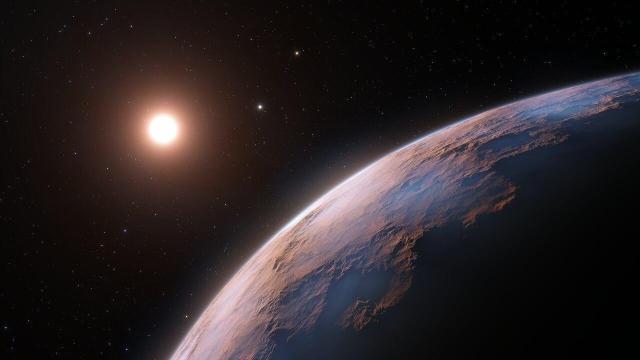Proxima Centauri, a tiny star located a mere 4.25 light-years from Earth, may host a third planet, according to new research.
The nearest star to Earth is a surprisingly busy place, or at least it’s looking that way. Astronomers have announced the discovery of a candidate planet around Proxima Centauri, adding to the two already known to orbit the star. Astronomer João Faria from the Institute of Astrophysics and Space Sciences in Portugal is the lead author of the new paper, published today in Astronomy & Astrophysics.
Finding Proxima d, as the exoplanet is called, wasn’t easy owing to its exceptionally low mass. At one-quarter the mass of Earth, it the lightest of the three planets and also the lowest-mass planet ever detected by astronomers. Prior to this, the record for lightest exoplanet belonged to L 98-59 b, an exoplanet with roughly half the mass of Venus.
“The discovery of low-mass planets in multiple systems like this adds to the overall picture that these kind of planets are likely the most common in our galaxy and also quite common around [red dwarf] stars such as Proxima [Centauri],” Faria told me in an email. Proxima Centauri is part of a triple star system, its companions being Alpha Centauri A and B.
To make the detection, Faria and his colleagues turned to the radial velocity technique. It works by detecting minute perturbations in a star resulting from the gravitational pull of an orbiting planet. The chosen tool for the job was Echelle SPectrograph for Rocky Exoplanets and Stable Spectroscopic Observations (ESPRESSO) instrument attached to the European Southern Observatory’s Very Large Telescope in Chile. Hints that a third planet might exist emerged in 2020, when ESPRESSO confirmed the existence of Proxima b (the first candidate planet detected in this system, first spotted in 2016), prompting a second look in 2021.
For the new study, the team analysed a set of 114 ESPRESSO observations of Proxima Centauri, providing a clear signal of the candidate planet. The wobbles produced by Proxima d were tiny: The planet caused its host star to oscillate a mere 15.75 inches (40 centimeters) each second.
That we can detect such a thing from a distance of 4.25 light-years blows my mind, but to be fair, this is still a candidate planet, as more observations will be needed to confirm its existence. Proxima d is being referred to as a candidate, “not because the detection itself is not robust, but because it needs to be confirmed by other instruments and other detection techniques,” said Faria. To which he added: “I would also mention that in the initial discovery of Proxima b, the word candidate was also used, for exactly the same reasons.”
Faria said it was very challenging to detect the planet, as it involved a complicated analysis of the data. It’s interesting to know, he said, that’s “it is now possible to detect these low-mass planets,” which makes him wonder about future discoveries. He also found it surprising that, “of all the stars, the closest one to the Sun was still ‘hiding’ some secrets.”
Proxima d orbits its star at a distance of 4 million km, which is less than one-tenth the distance of Mercury to the Sun — extremely close, by the standards of our solar system. It’s important to keep in mind, however, that Proxima Centauri is a small and dim red dwarf that’s not nearly as powerful as the Sun. That said, Proxima d is not located inside the star system’s habitable zone — the band within which liquid water can persist on the surface — owing to its close proximity; a year on Proxima d lasts just five days.
“The mass is the main piece of information available from the radial velocity technique,” said Faria. “From it we can deduce that the planet is likely rocky, but we don’t know its composition or atmosphere.”
Our understanding of the planetary system around Proxima Centauri is starting to take shape. In terms of the other two planets, Proxima b is an Earth-sized world parked inside the habitable zone, while Proxima c is a super-Earth located farther out. A year on Proxima b lasts for 11 days, whereas a year on Proxima c lasts for five years.
Last year, scientists announced TOLIMAN — a telescope dedicated to searching for potentially habitable planets around the three Alpha Centauri stars. Sadly, it doesn’t appear that Proxima d will fit into that important category.
More: The Search for Life Around Alpha Centauri Just Took a Major Leap Forward.
